
Discover the world of Australian opals, celebrated gems known for their unique patterns and intense colors. This article provides an insight into the diverse types of Australian opal, from the iconic black opal to the striking boulder opal, their origins, and practical care techniques to maintain their luster.
- Key Takeaways
- The Allure of the Australian Black Opal
- Discovering Boulder Opal’s Natural Artistry
- The Classic Charm of White Opals
- The Ethereal Beauty of Crystal Opals
- Doublet and Triplet Opals
- The Diverse Spectrum of Opal Types
- Opal Care and Maintenance
- Summary
1 KEY TAKEAWAYS
-
Australian black opals are the most valuable opal variety due to their rare dark body tone that enhances their internal color play, with red hues adding to their rarity and value, combined with the challenging mining conditions at Lightning Ridge.
-
Boulder opals, unique to the ironstone boulders in which they form, are valued for their natural artistry with distinctive color patterns that require masterful cutting to reveal, also involving a respectful mining process that considers indigenous rights.
-
While white and crystal opals offer classic and ethereal beauty respectively, doublet and triplet opals provide more affordable beauty with careful layered construction, though they require cautious handling to maintain their condition and vibrancy.
2 THE ALLURE OF THE AUSTRALIAN BLACK OPAL
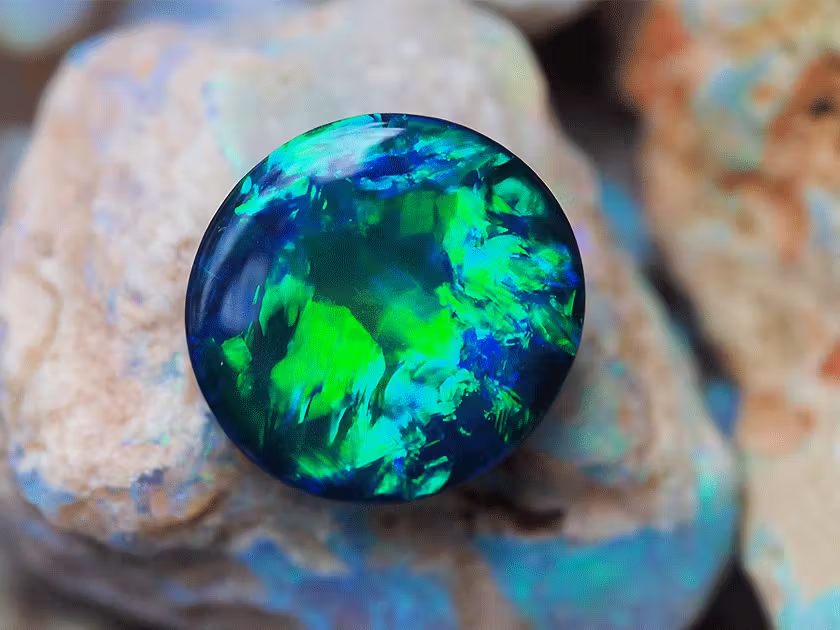
Australian Black Opal by The Opal Centre
The Australian black opal possesses a unique enchantment. Sourced from the remote Lightning Ridge, these opals are renowned for:
-
Their mesmerizing play of color, a spectacle that’s as captivating as the southern night sky
-
Their rarity, coupled with their stunning array of internal colors
-
Being the most sought after and valuable among opal varieties
What makes black opals attractive is not just their vibrant hues, but their distinct black body tone, graded from N1 to N4. This dark backdrop enhances the intensity of the opal’s internal colors, creating a contrast that amplifies their overall appeal. Interestingly, the presence of red hues in black opals, due to their rarity, pushes their value even higher, making them a truly precious gemstone in the market.
Yet, the appeal of black opals goes beyond their stunning aesthetics. The challenging mining conditions and the presence of black potch, a type of opal material, contribute to their scarcity. As a result, the value of black opals has continued to soar, making them not just a delightful visual spectacle but also a worthy investment.
3 DISCOVERING BOULDER OPAL’S NATURAL ARTISTRY
Visualize a gemstone embodying nature’s artistry in all its facets. That’s precisely what the boulder opal offers. These opals form in the cracks and crevices of ironstone boulders through a fascinating process where silica-rich water seeps in and leaves behind a solid silica gel that hardens into opal. This process of formation culminates in the characteristic play of colors or opalescence, which is especially dramatic due to the contrasting dark ironstone matrix it forms within.
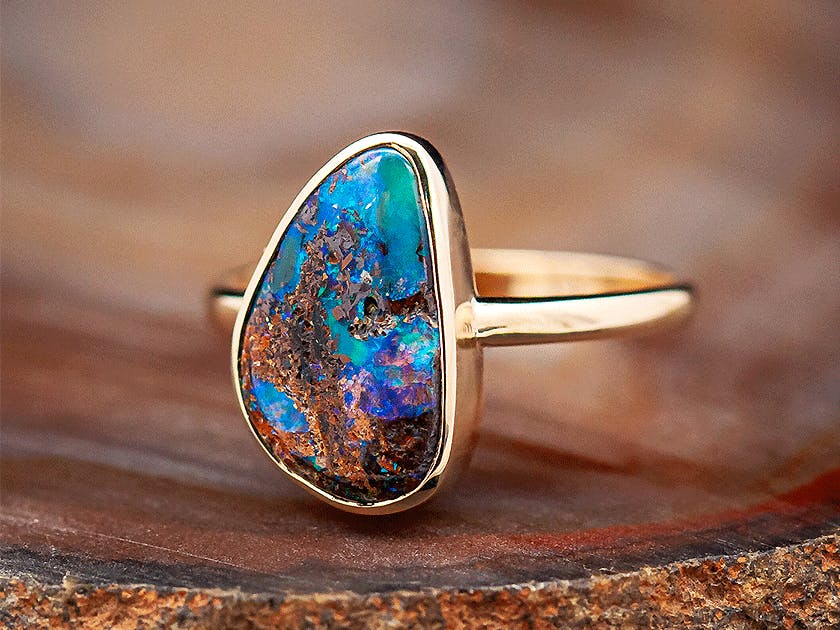
Australian Fossil wood Opal Ring by World Treasure
The ironstone matrix of boulder opal, rich in iron minerals, provides stability and greatly influences the opal’s distinctive patterns. These patterns can include veins, swirls, and other intricate designs that make every boulder opal a unique masterpiece. However, revealing the beauty of boulder opal is an art in itself. It requires skillful hand-carving by a master gem cutter to ensure the intricate color patterns are showcased.
Extracting boulder opal is an intricate process. It involves carefully identifying and extracting opal-bearing boulders, followed by precision cutting and polishing to unveil the gemstone’s vibrant colors. Furthermore, opal mining operations must respect Native Title laws, with agreements obtained from local Aboriginal tribes before any mining can begin. This respect for indigenous rights and the careful extraction process further add to the charm and value of boulder opals, especially when considering the opals mined.
4 THE CLASSIC CHARM OF WHITE OPALS
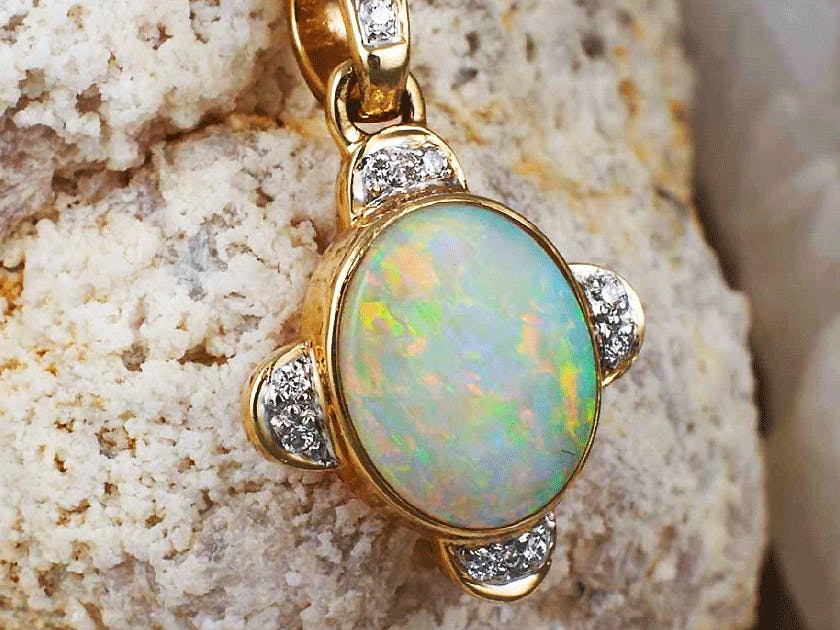
Diamond Australian White Opal Necklace from Australian Opal Direct
Within the assortment of Australian opals, the white opal possesses a timeless allure. These opals, primarily mined in South Australia’s Coober Pedy region, are the most commonly encountered type of Australian opal. Distinguished by their pale white or light body tone, white opals offer a play of color that spans the full color spectrum, making them a classic choice for opal enthusiasts.
Although they might not be as rare as black or boulder opals, white opals are equally mesmerizing. They are more plentiful and may possess a white potch on the back, indicating colorless opal. Despite their relative abundance, the lighter body tone of white opals typically results in less vibrant color displays than those found in boulder and black opals. This contributes to their lower market value but in no way diminishes their classic appeal.
5 THE ETHEREAL BEAUTY OF CRYSTAL OPALS
Immerse yourself in the clear charm of crystal opals, a type of natural opal that appears to have encapsulated a fragment of the sky. These opals, including the stunning crystal opal, are known for their transparent to semi-transparent clarity, creating a clear background that elevates their play-of-color and distinguishes them from other types of opal, such as solid opal, precious opal, and rough opal.
Supreme quality crystal opals showcase an outstanding play-of-color, potentially featuring patterns such as:
-
pinfire
-
harlequin
-
flame
-
peacock
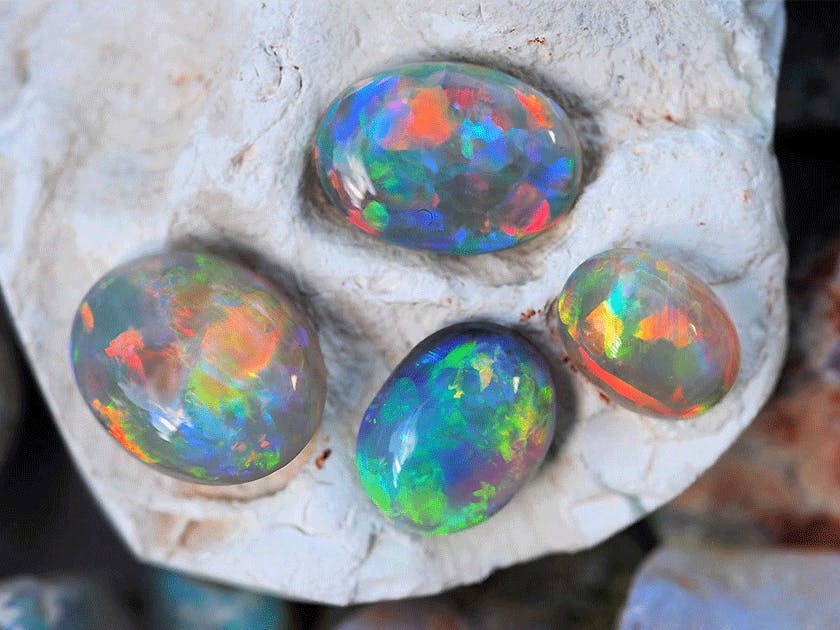
Crystal Opal from The Opal Centre
The most sought-after crystal opals are those with large, bright, and closely arranged patches of color, creating a mesmerizing spectacle of light and color.
Among crystal opals, dark opal, also known as black crystal opals, are particularly rare and valuable. These opals feature a very dark background that remains transparent enough to showcase a stunning play-of-color. The combination of a dark backdrop with the stunning color displays makes black crystal opals a unique gem, a rare beauty in the world of opals.
6 DOUBLET AND TRIPLET OPALS
For opal enthusiasts seeking an affordable, yet classy option, doublet and triplet opals are ideal. These types of opals are crafted using layers to amplify the color vibrancy. Doublet opals are crafted using two layers: a slice of light opal and a dark backing, which enhances the color intensity. Triplet opals, on the other hand, have three layers: a thin slice of light opal, a dark backing, and a clear cap that magnifies the colors and serves as a protective layer.
In terms of cost, triplets are approximately 1/40th the price of a black opal, offering a cost-effective option with a composition that includes a magnifying lens over the opal layer. Doublets often cost more than triplets because they utilize a thicker slice of opal, whereas triplets are less expensive due to their thin opal slice and often synthetic top layer.
Despite offering attainable elegance, doublets and triplet opals demand cautious handling to guarantee their lasting brilliance. Here are some tips for taking care of them:
-
They should never be soaked during cleaning.
-
They should be stored in conditions that prevent them from drying out and becoming brittle.
-
Preserving the moisture content of these opals is key to maintaining their vibrant beauty.
7 THE DIVERSE SPECTRUM OF OPAL TYPES
Australian opals cover a wide variety of types, each boasting its unique allure and traits. The types of opals include:
-
Black Opals
-
Boulder Opals
-
White Opals
-
Crystal Opals
-
Doublets and Triplets
The black body tone characteristic of some opals is due to the presence of iron oxide and carbon. This gives them their distinct dark backdrop, which greatly enhances the visual impact of their vibrant color displays. Fire opals, on the other hand, are less popular for engagement rings because they are prone to cracking, making them less suitable for everyday wear.
8 OPAL CARE AND MAINTENANCE
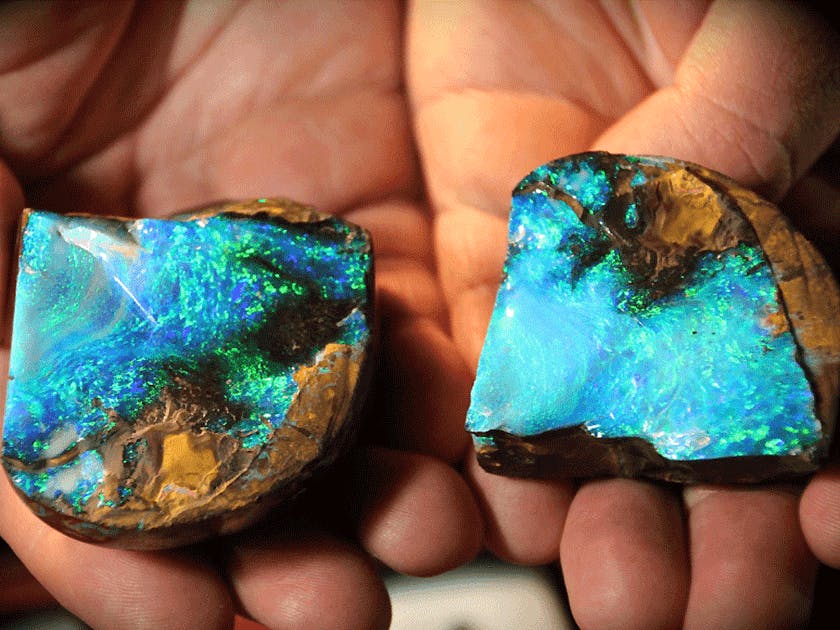
Australian Opal Crystal by Bell & Brunt
Ensuring the beauty and longevity of your opals necessitates proper care and maintenance. Cleaning opals requires gentle handling; soft rubbing with a cloth and mild detergent in tepid water is recommended, while avoiding harsh cleansers and ultrasonic cleaning. Doublet and triplet opals require special care; they should not be soaked or immersed as water exposure can damage these stones.
Besides careful cleaning, opals should be taken off before participating in activities such as:
-
sports
-
gardening
-
household chores
-
bathing
This is to prevent potential jewelry damage. Protection from scratches and blows is crucial, with special attention to corners which are more prone to chipping.
Additionally, it’s recommended to regularly inspect opal jewelry to examine the gemstones and their settings. If your opals have become dull or scratched, professional polishing is available to restore their brilliance.
9 SUMMARY
Embarking on this exploration of the radiant world of Australian opals, it’s clear that these gemstones offer a unique blend of beauty, diversity, and allure. From the captivating play of color in the Australian black opal to the stunning transparency of crystal opals, each type of opal has its own distinct charm that makes it a precious treasure.
As we’ve seen, the value of these gemstones goes beyond their visual appeal. Their rarity, the challenging mining conditions, and the intricate crafting processes all contribute to their high value. Furthermore, proper care and maintenance are crucial to maintaining their beauty and prolonging their longevity.
In conclusion, whether you’re a seasoned gemstone enthusiast or a beginner just starting to explore the world of opals, remember that each opal is a unique masterpiece. Whether it’s a classic white opal, a rare black opal, or an affordable doublet or triplet, each opal holds a piece of Australia’s unique geological story, ready to be discovered and treasured.
